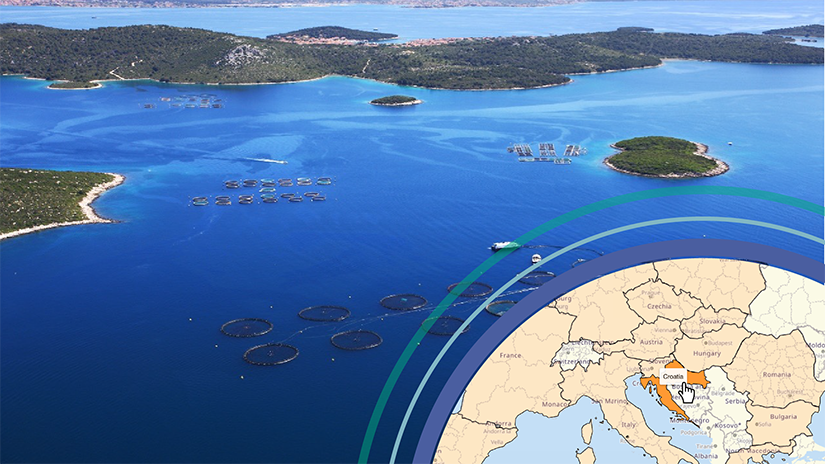Background information

Type of species farmed
Main species are gilthead seabream (Sparus aurata), European seabass (Dicentrarchus labrax), Atlantic bluefin tuna (Thunnus thynnus), meagre (Argyrosomus regius), common carp (Cyprinus carpio) and other herbivorous carp species, rainbrown trout (Oncorhynchus mykiss), brown trout (Salmo trutta), wels catfish (Silurus glanis), zander (Sander lucioperca), pike (Esox lucius), Mediterranean mussel (Mytilus galloprovincialis) and European flat oyster (Ostrea edulis).
Source: 2023, EUMOFA; Ministry of Agriculture – Directorate of Fisheries, MA-DoF
Type of production method
In 2022, more than 84% of Croatian production occurred in marine waters and the rest in freshwater. The following main production methods were used:
Sector’s size (production and consumption)
Source: MA-DoF; 2024, EUMOFA
Trends (past and future)
The sustainable development of the aquaculture sector through the improvement of aquaculture productivity in a climate-smart and sustainable way, using new digital technologies and innovations, strengthening the competitiveness of the sector and the contribution of the aquaculture sector to the development of rural and coastal economies.
Source: MNSPA-NPRA 2027
Impact of aquaculture in the country’s economy, food market and labour market
The majority of aquaculture farms are microscale enterprises, particularly small family-owned shellfish farms, which, despite their social value, don’t contribute significantly to total production volume and value.
However, the medium and large companies in marine aquaculture segment (tuna, seabass and seabream) are in minority by number, but participate in total production with more than 80%, representing the most important segment of aquaculture industry.
In freshwater aquaculture sector predominate small scale companies with participation in total production of some 15%, but with a significant importance for the maintenance and conservation of biological diversity (majority of carp ponds are Natura 2000 sites), and with the potential to boost development and jobs in the inland and rural areas of the country.
Source: EuroFish; MA-DoF
Challenges and opportunities
- Diversification of species and products, further technological development of the sector,
- Non-existence of producer organisations,
- Need for improvements in marketing and branding activities,
- Further improvements in application of good practices and protocols for animal health and welfare management,
- Insufficient processing capacities and production of products with a higher added value, especially in some segments of the sector (freshwater aquaculture and shellfish farming),
- Market instability and high production costs (small-scale shellfish farmers),
- Increasing the productivity,
- Strengthening the competitiveness of the aquaculture sector.
- Looking at adaptation to climate change, by strengthening the resilience of the entire aquaculture sector, but also by mitigating climate change through the use of innovative technologies that contribute to the vision of low-carbon economy.
- The contribution of the aquaculture sector to restoring rural and coastal economies and improving living conditions in rural and coastal areas.
- Fostering innovation in the aquaculture sector.
Source: MNSPA-NPRA 2027
Employment and number of enterprises
177 enterprises in 2023
Source: MA-DoF
Multi-annual National Strategic Plans for the development of sustainable Aquaculture
Decision of the Government of RC on the approval of NPRA 2027 (in Croatian): https://narodne-novine.nn.hr/clanci/sluzbeni/2022_11_133_1998.html
Relevant Authorities
Applicable Legislation
- Aquaculture Act: No. 130/2017, No. 11/2018, No. 144/2020 and No. 30/2023
- Ordinance on the Register of licences for the use of alien and locally absent species in aquaculture, the Register of Imports and Transfers and the List of Closed Aquaculture Facilities No. 10/2018
- Ordinance on Licence for Aquaculture No. 17/2018
- Ordinance on Professional Training for Aquaculture Activities No. 56/2018
- Ordinance on Criteria for Establishing Areas for Aquaculture on the Maritime Domain No. 106/2018
- Ordinance on the collection of statistical data on aquaculture: No. 137/2021 and No. 87/2022
- Ordinance on approval for performing aquaculture activities on family agricultural farms
- Ordinance on the disposal of tuna farming capacity and permitted input quantities of caught wild tuna (Thunnus thynnus) to farms: No. 22/2021, No. 9/2022, No. 8/2023 and No. 9/2024
- Ordinance on labelling of farming installations, monitoring of operations on farms and traceability during bluefin tuna farming (Thunnus thynnus) No. 63/2022
- Ordinance on Registry of aquaculture vessels No.61/2023
Applicable Procedures
Other Relevant Documents
National associations and networks
- Croatian Chamber of Economy, Sector for Agriculture, Fisheries Association
- Croatian Chamber of Trades and Crafts, Fisheries and Aquaculture Guild
- Mariculture Cluster
- Ston Shellfish Farmers Association
Contact Details
Ministry of Agriculture - Directorate of Fisheries
Tatjana Boroša Pecigoš, Head of Service for Aquaculture
- Telephone number: +385 1 6443 190
